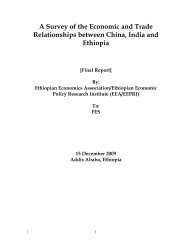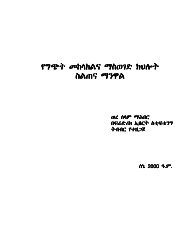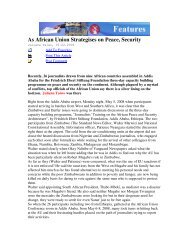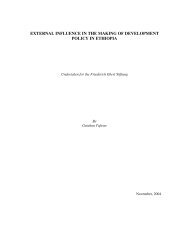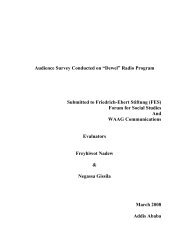Ethiopia and EPA Negotiation 2008 - FES Ethiopia
Ethiopia and EPA Negotiation 2008 - FES Ethiopia
Ethiopia and EPA Negotiation 2008 - FES Ethiopia
Create successful ePaper yourself
Turn your PDF publications into a flip-book with our unique Google optimized e-Paper software.
Lifting the export tax will considerably undermine the production capacity of<br />
<strong>Ethiopia</strong>n tanneries. All the tanneries are currently working under their full<br />
capacity because of the critical shortage of raw hides <strong>and</strong> skins. Lifting the<br />
export tax while there is this evident shortage of supply will lead to closure of<br />
more than half of the tanneries. Similarly, eliminating the export tax would arrest<br />
the transition to export of value added products.<br />
5.4 Scope of Liberalisation<br />
Free Trade Agreements by definition restrict states’ freedom to manoeuvre –<br />
that is their intention. Countries choose between the advantages of constraints<br />
to other countries’ policy freedom <strong>and</strong> the disadvantages of constraints on their<br />
own when they negotiate any trade deal. Arguably, the single largest loss of<br />
policy space that takes place when each country joins an FTA or the WTO is the<br />
loss of freedom to impose custom duties or vary them, as the case may be.<br />
However, this doesn’t mean there are no flexibilities. For instance, in the current<br />
Doha negotiations LDCs are exempted from having to make any market access<br />
concessions. Under the Interim <strong>EPA</strong>s, countries are required to allow a minimum<br />
of 80% of EU imports to enter duty free with a period of 25 years. For the ESA<br />
countries, the transitional period is only 15 years. In the EAC Interim <strong>EPA</strong>-which<br />
includes four LDCs, 82% of the region’s import from EU will be liberalised. 62% will<br />
be liberalised within 2 years, <strong>and</strong> 80% within 15 years <strong>and</strong> only the final 2% within<br />
25 years. There is no justification or even claim that these concessions are<br />
designed to be consistent with the countries development needs. The EC’s one<br />
–size- fits –all approach of requiring liberalisation of a minimum of 80% of import<br />
from EU within a transition period of 25 years doesn’t even make a distinction<br />
between LDCs <strong>and</strong> developing countries. The market access commitments in<br />
the interim <strong>EPA</strong>s are out of proportion to what is being requested of LDCs in the<br />
Doha Round although admittedly the Doha Round is not a free trade<br />
negotiation.<br />
Obviously, as the scope of the liberalisation widens the revenue loss from tariff<br />
collection increases. This is significant given the stage of development of most<br />
of these counties. This will be an added burden given the weakness <strong>and</strong><br />
administrative difficulty in collecting o internal taxes <strong>and</strong> will affect the<br />
government’s expenditure for other objectives such as health <strong>and</strong> education.<br />
5.5 Prohibition of the Use of Quantitative Restrictions<br />
Article 17 of the ESA Interim Agreement provides that “except as specified in the<br />
Annexes, all prohibitions or restrictions in trade on the importation, exportation or<br />
20 | P a g e



